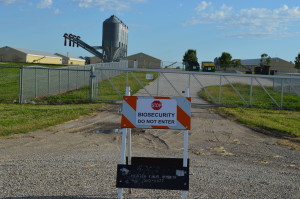
Quarantines have been lifted on all of Iowa’s commercial poultry sites in the wake of bird flu, officials announced on Nov. 6, 2015. (photo/Cindy Hadish)
Several backyard chicken operations remain under quarantine in Iowa following this year’s bird flu outbreak, but state officials announced today that all commercial operations have been given approval to restock their farms.
The disease affected more than 31 million chickens and turkeys in Iowa and led to countries such as China, South Korea and South Africa banning all U.S. poultry products, with many others restricting products from individual states or counties.
During a conference call today with reporters, Iowa Agriculture Secretary, Bill Northey, noted that the backyard operations have a 180-day waiting period to restock, rather than going through the cleaning process undertaken at commercial sites.
Gretta Irwin, executive director of the Iowa Turkey Federation, said turkeys for Thanksgiving are not affected by Iowa’s bird flu outbreak, as Iowa’s turkeys are toms that are used in ground turkey and other processed products.
Randy Olson, executive director of the Iowa Poultry Association, said it may take through 2016 and into 2017 for affected egg producers to be fully back up to pre-bird flu numbers.
Before the outbreak, Iowa had about 60 million layer hens. That number was down to 33.9 million in September, Northey said.
Learn about bird flu in Iowa, including tips for backyard chickens, and read on for more from the state about today’s announcement:
Safety tips for backyard flocks
Iowa rebuilding flocks after bird flu
DES MOINES – The Iowa Department of Agriculture and Land Stewardship and U.S. Department of Agriculture today announced that all of the 72 commercial poultry farms that had a confirmed case of Highly Pathogenic Avian Influenza have had the quarantines on their facilities lifted and are eligible to restock birds.
All sites have completed the cleaning and disinfection process and had negative environmental tests. They also had to undergo a 21 day fallow period following disinfection before the quarantine could be lifted.
Five backyard operations remain under quarantine. Backyard facilities must undergo a 180 day fallow period following depopulation before the quarantines can be lifted and birds brought back to the farm. It is anticipated that these sites will be able to come off of quarantine in the next month.
Biosecurity continues to be emphasized to protect birds.
Now that fall migration of wild waterfowl is underway, bird owners are again reminded to exercise biosecurity to prevent the return of the disease. USDA Animal and Plant Health Inspection Service (APHIS) issued a report last month on its planning and preparation for a potential recurrence of the disease.
APHIS’ fall plan focuses on four major areas: preventing or reducing future outbreaks; enhanced preparedness; improved and streamlined response capabilities; and preparing for the potential use of AI vaccines.
APHIS’ fall planning report not only discusses planning and preparedness activities but also contains links to updated policies, guidance documents, and background information, including a biosecurity self-assessment for the poultry industry, criteria for using ventilation shutdown as a depopulation method and a plan for how vaccine could potentially be used.
The Iowa Department of Agriculture and Land Stewardship, together with USDA, partner state agencies and industry stakeholders have conducted after-action reviews and preparedness planning.
Learn more at the USDA’s Avian Influenza page, which includes a link to the Fall Plan.
The Iowa HPAI response operates under a Unified Command involving the Iowa Department of Agriculture and Land Stewardship (IDALS) and USDA Animal and Plant Health Inspection Service (APHIS) Veterinary Services.
There were 77 total premises and 31.5 million birds affected with H5N2 HPAI in Iowa. There are 35 commercial turkey flocks, 22 commercial egg production flocks, 13 pullet flocks, 1 chicken breeding flock, 1 mail order hatchery, and 5 backyard flocks.
Updated information about the number cases, when they are confirmed and other relevant information will be posted to the Iowa Department of Agriculture and Land Stewardship’s website.
The Center for Disease Control (CDC) and Iowa Department of Public Health considers the risk to people from these HPAI H5 infections in wild birds, backyard flocks and commercial poultry, to be low. No human infections with the virus have ever been detected and there is no food safety risk for consumers.

No Comments Yet